How to calculate your score in C2 Proficiency
Knowing and understanding your score in the different Cambridge exams can be very helpful as it clarifies the marking scale and what the the numbers on your certificate mean. It is also quite confusing that there is the need to convert your marks into a score just to know how well you did in the test.
With all that being said, I hope that at the end of this article, you will be able to put your marks and scores in context and better understand how to get to your score and what it means in the bigger picture of Cambridge English examinations.
The two different ‘scores’
For many candidates, it is really confusing that there are marks, which you receive for your correct answers, as well as a score you are awarded for each exam paper based on those marks. While in the past, there was a straightforward pass-or-fail system in place, now there is bit more to think about when you get your results.
First of all, let me give you some context. In 2015, Cambridge introduced a scoring scale which replaced the previous pass-or-fail system. The new scale made it easier to compare different exams within the Cambridge frame work as well as other tests like IELTS or TOEFL. While marks were still a good indicator for how well someone did, the score now tells another story that has made the results more meaningful.
You might think now that this still sounds really complex, but I assure you that if you go with a rough estimate of 60% as a passing grade, you are still correct. However, if you are intrigued, let’s go down this rabbit hole together and see what Wonderland looks like.

The Cambridge English Scale explained
As mentioned before, Cambridge introduced their new system to report exam results in 2015 and they have been using it ever since.
While you still receive marks for any correct answers in the exam, your certificate only gives you a score whose value depends on the marks as well as the exam you take.
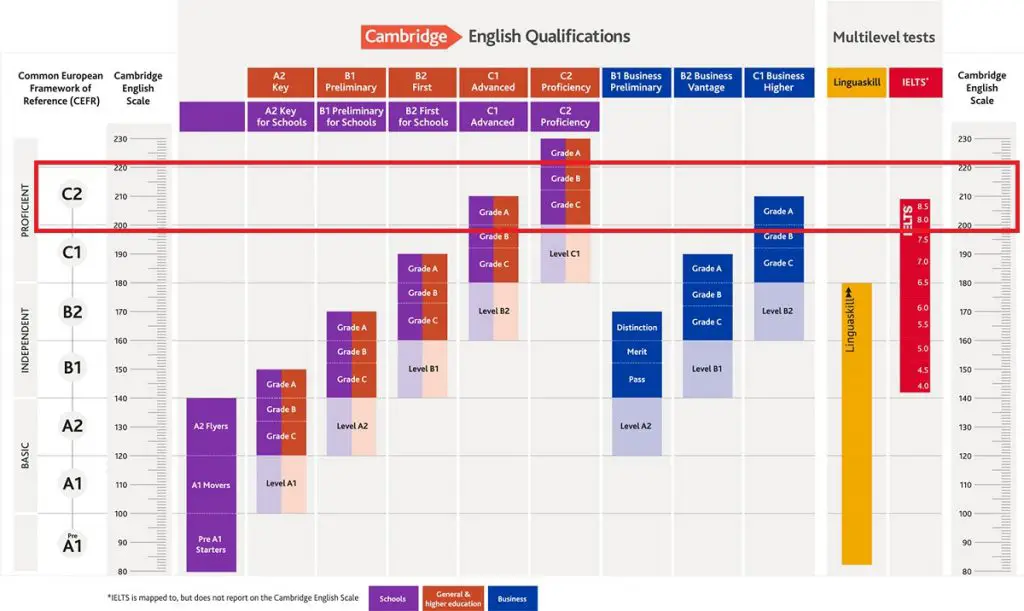
In the image above, you can see what the Cambridge English Scale looks like. I’ve highlighted C2 level for you so you can see where it lands on the scale as well as in comparison to other examinations (here: Linguaskill and IELTS). In order to pass C2 Proficiency you need to reach a score of at least 200.
With this scale Cambridge put all their exams in relation to each other. You can see how they are interconnected and it even becomes clear that you can achieve C2 level taking the C1 Advanced exam and scoring above 200, which previously wasn’t really an option.
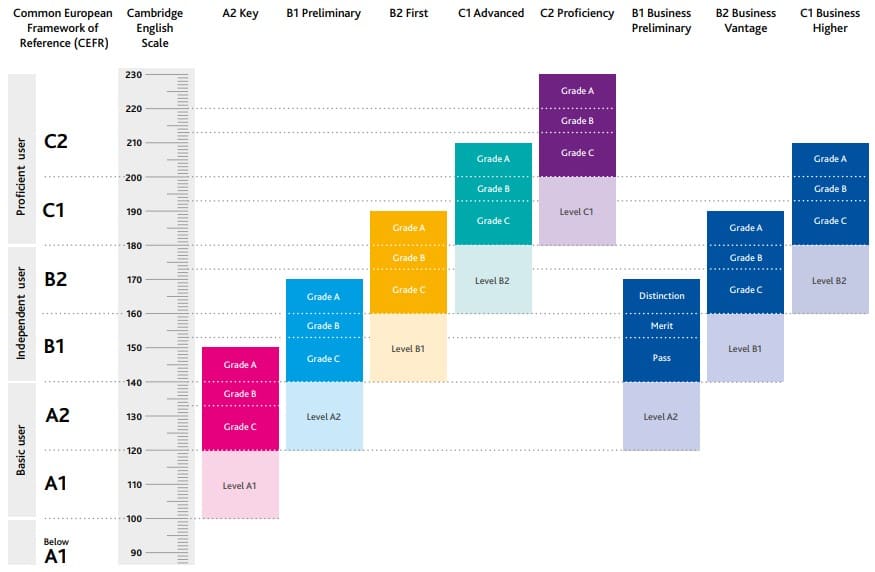
The different parts of Cambridge C2 Proficiency
When you take C2 Proficiency you have to wait for a little while until you receive your results. A typical certificate looks something like this:

In this example, the candidate scored 186 or more in each exam paper and 205 overall, which is a passing score.
Of course, the complicated thing is to know where these scores come from and how many marks the candidate got for how many correct answers.
When you take the official exam you won’t be able to review your own test so you will never know exactly which of your answers were correct or wrong, but what I’m going to show you will help you when you practise and want to know what your marks would mean on the Cambridge English Scale.
Reading
Reading and Use of English are always together in one exam paper in C2 Proficiency, but they are marked separately and you receive two scores, so first of all, it is important to know which of the seven parts belong to which test.
- Reading counts 20% towards your overall score.
- Parts 1, 5, 6 and 7 of the exam paper belong to Reading.
- For parts 1 and 7, you score one mark for each correct answer while in parts 5 and 6, you are awarded two marks for a correct answer.
- There is a total of 44 possible marks in this part of the exam.
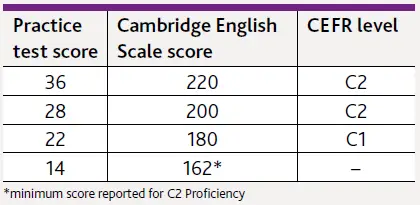
In this image, you can see the converted scores for the Reading test in C2 Proficiency. The marks for correct answers are in the left column, the score on the Cambridge English Scale in the middle and the CEFR level this score translates to on the right. To pass you need to reach C2 so in this case, at least 28 marks or a scale score of 200.
Use of English
As we said earlier, there are four parts (1, 5, 6 and 7) that belong to Reading so all that’s left for Use of English are parts 2, 3 and 4.
- Use of English counts 20% towards your overall score.
- Only parts 2, 3 and 4 of the exam paper belong to Use of English.
- Each correct answer in parts 2 and 3 is worth one mark while you can score up to two marks for a fully correct answer in part 4.
- You can score a maximum of 28 marks in this paper.
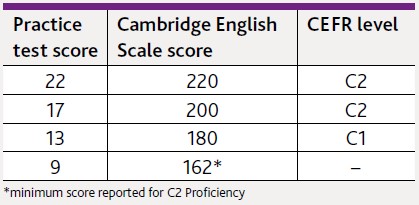
Listening
Listening is probably the easiest part of C2 Proficiency in terms of marking. There are no hidden possibilities or options. Everything is straightforward.
- Listening makes up 20% of your overall score.
- Every part of this paper counts toward the score in the listening test.
- You get one mark for each correct answer.
- There is a maximum of 30 marks in this test.
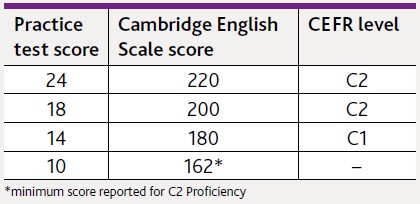
Writing
The scoring in the writing paper is a little bit more complex than in the previous sections of C2 Proficiency because you have to write two texts, each of which is marked separately, but then the marks are combined to give you your final score in this test.
Without going into too much detail, however, let’s see what your marks can get you.
- Writing counts 20% towards your overall score.
- The two texts carry equal weight when they are marked.
- There are four marking criteria with a maximum of 5 marks awarded for each.
- As you write two texts, there is a total of 40 marks in this paper.

Speaking
The speaking test is probably the most complicated to mark. Just as in the writing test, there are different marking criteria, but they are not weighted equally so there’s some maths to be done before the final mark count is clear.
- Speaking makes up 20% towards your overall score.
- The marking criteria count differently towards the result of the speaking test.
- You can get up to 5 marks in each of the following criteria:
- Grammatical Resource (multiplied by 2, so 10 possible marks)
- Lexical Resource (multiplied by 2, so 10 possible marks)
- Discourse Management (multiplied by 2, so 10 possible marks)
- Pronunciation (multiplied by 2, so 10 possible marks)
- Interactive Communication (multiplied by 2, so 10 possible marks)
- Global Achievement (multiplied by 5, so 25 possible marks)
- There is a total of 75 marks in this paper.

Is there still a way to fail C2 Proficiency?
The short answer to this question is no. Technically, there is no ‘fail’ grade anymore, but you can definitely score not enough marks to reach a score of over 200 on the scale. In this case, your result will be reported as C1, which you could consider as a failed exam if your goal was to reach C2.
So remember, in order to ‘pass’ Cambridge C2 Proficiency you have to reach a score of at least 200 on the Cambridge English Scale.
More information
You can find out a little bit more about the Cambridge English Scale with the video below and if you want more information about the C2 Proficiency exam in general, check out my article on the topic.
I hope you have a better understanding of the marking system in Cambridge C2 Proficiency and I look forward to giving you more useful info in the future.
Lots of love,
Teacher Phill

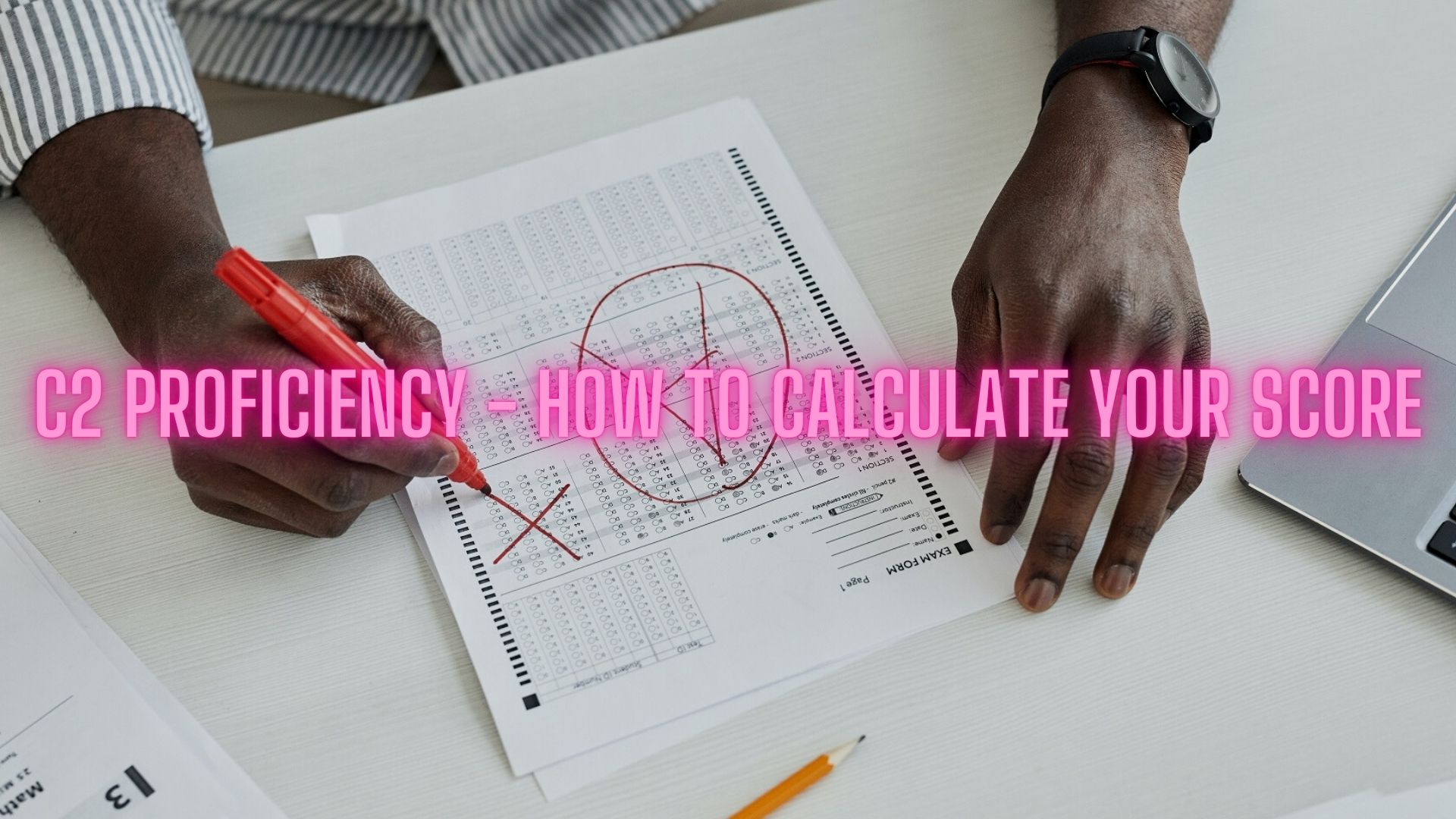






Dear Phil,
thanks, incredibly helpful overview. Question: the sum of the maximum scores seems to be 217, whereas the scale goes up to 220. Am I miscalculating or missing something?
Thanks, Paul
Hi Paul,
The possible marks of 217 and the possible scale score of 220 are two separate things. Your marks are converted to a scale score for each exam paper (Reading, Use of English, Writing, Listening, Speaking) and the average of these five scale scores determines your overall scale score.
For example, if you have 44 marks in Reading, you get a scale score in Reading of 220. If you have 22 marks in Use of English, you get a scale score in Use of English of 220, etc.
I hope that clarifies what the difference is.
Hi Phil,
I’ve read your explanation about scoring (parts of) the Cambridge CPE. I have a question about my Statement of Result. My writing part states a score of 205. As I was trying to reconstruct my overall score it looks like a 205 is simply impossible to achieve. On multiple scorers I saw that only 204 and 206 are possible. Am I correct? Do you have any expertise on this?
Kind regards,
Ruud
Hi Ruud,
I am definitely not an expert on the formula Cambridge uses to extrapolate your score, but I don’t see why 205 shouldn’t be possible.
Thank you for your comment Phill.